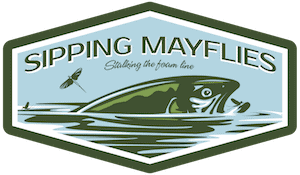Fly Fishing For Crappies
May 18th, 2023
Crappies are hard-fighting fish that are found across the entire United States, and are a worthy gamefish to target with your fly rod. They get bigger than other panfish such as bluegills, and they’re more aggressive with much larger bass-like mouths.
I’ve had a lot of success fly fishing for crappies, and in the below article I’ll share with you my tactics and strategies for bringing them to the net. If you use what you learn here, you’ll have a crappie on the end of your line in no time.
Believe it or not, chances are excellent you have crappies within a short driving distance of wherever you are right now.
Both species of crappie (Pomoxis annularis and Pomoxis nigromaculatus) are, in my opinion, really fun to catch and quite tasty as a gamefish.
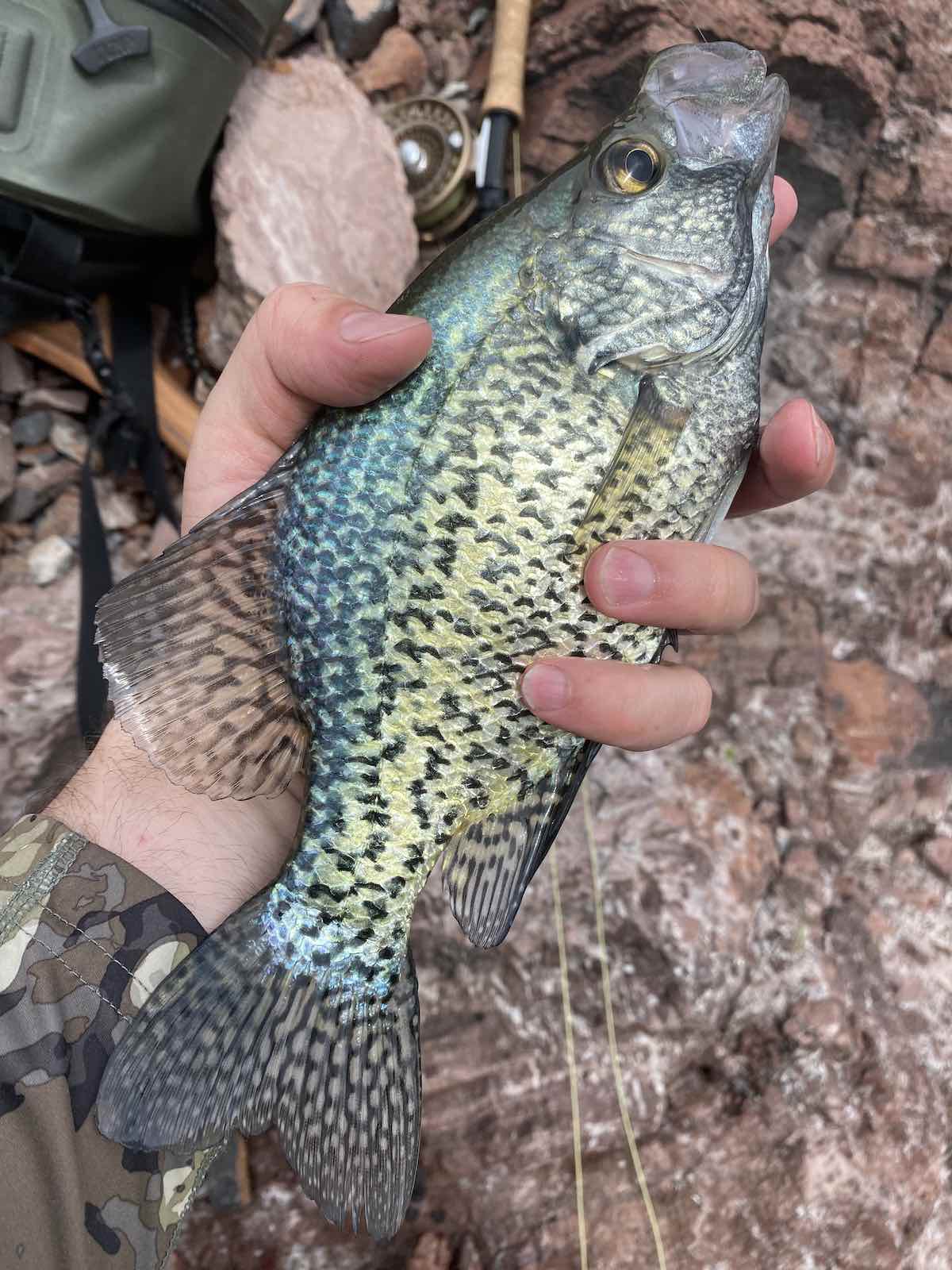
Here’s a beautiful black crappie (Pomoxis nigromaculatus) I caught in May near the tail-end of the spawning season. This fish was caught from the shoreline of a large reservoir and took a small streamer, as did many of its friends.
Where to Find Crappies
The white crappie (Pomoxis annularis) and the black crappie (Pomoxis nigromaculatus) can be hard to tell apart if you’re not familiar with them. The simplest advice I can give you is this: if your fish has dark vertical bars on its sides, it’s a white crappie. The dark bars aren’t clearly defined, but they’re noticeable.
I mentioned earlier that crappies are found all across the U.S., in both lakes, reservoirs, and rivers. They’re an adaptable species that can exist in huge numbers in certain bodies of water where conditions are ideal (prey, temperature, etc).
There aren’t any particular states that are the best for catching crappies, and the same fly fishing strategies will work on this species regardless of your region.
Here’s a USGS (United States Geological Survey) range map showing the estimated distribution of both species of crappie throughout the United States.
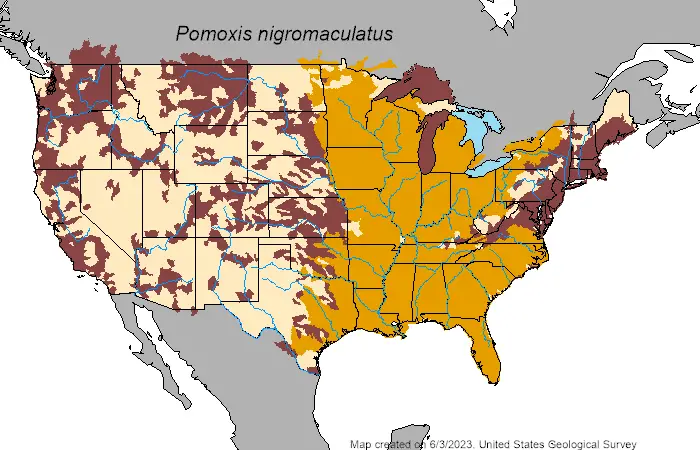
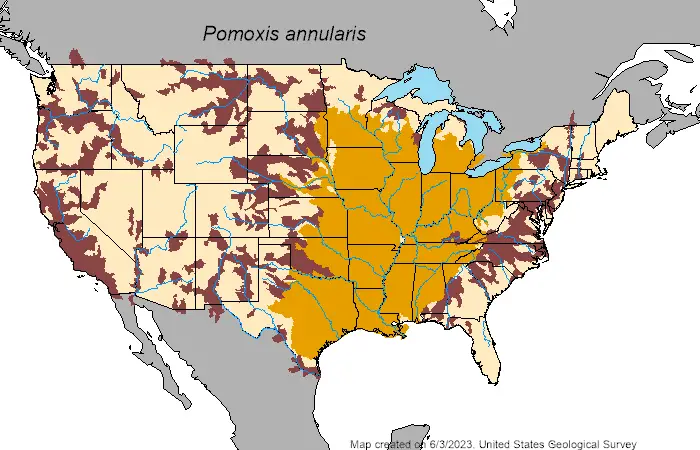
As you can see, both species have nearly identical ranges, and they often overlap.
In my personal experience, I don’t often catch both species in the same exact spot. So, maybe the two species tend to school separately. The two species don’t hybridize well, so my guess is it’s unnatural and they avoid it.
When you’re looking for crappies, don’t waste time casting your flies into shallow areas, or spots with a very gradual depth gain, such as gently sloping beaches. You’re not going to find crappies in those types of spots.
Instead, focus on bays that have deeper water (6-20 feet deep) with structure.
Examples of productive structure include underwater boulders and large rocks, submerged trees, and weedbeds. It should go without saying that crappies feel secure when they can hover near structure.
If you’re fly fishing for crappies from the shoreline, as I really like to do, find areas with a nice dropoff. Crappies will hold in the deeper water below a dropoff, while they wait to ambush prey such as minnows.
Fishing regulation are usually quite loose when it comes to crappies, and most states allow anglers to target them year round.
Crappies go by a few other names across the country, including calico bass, specks, papermouths, white perch, and in cajun Louisiana they’re called sac-a-laits which means “sack of milk” in French.
The world record black crappie was 5-pounds 7-ounces, and the world record white crappie was 5-pounds 3-ounces, so nearly identical sizes between the two species.
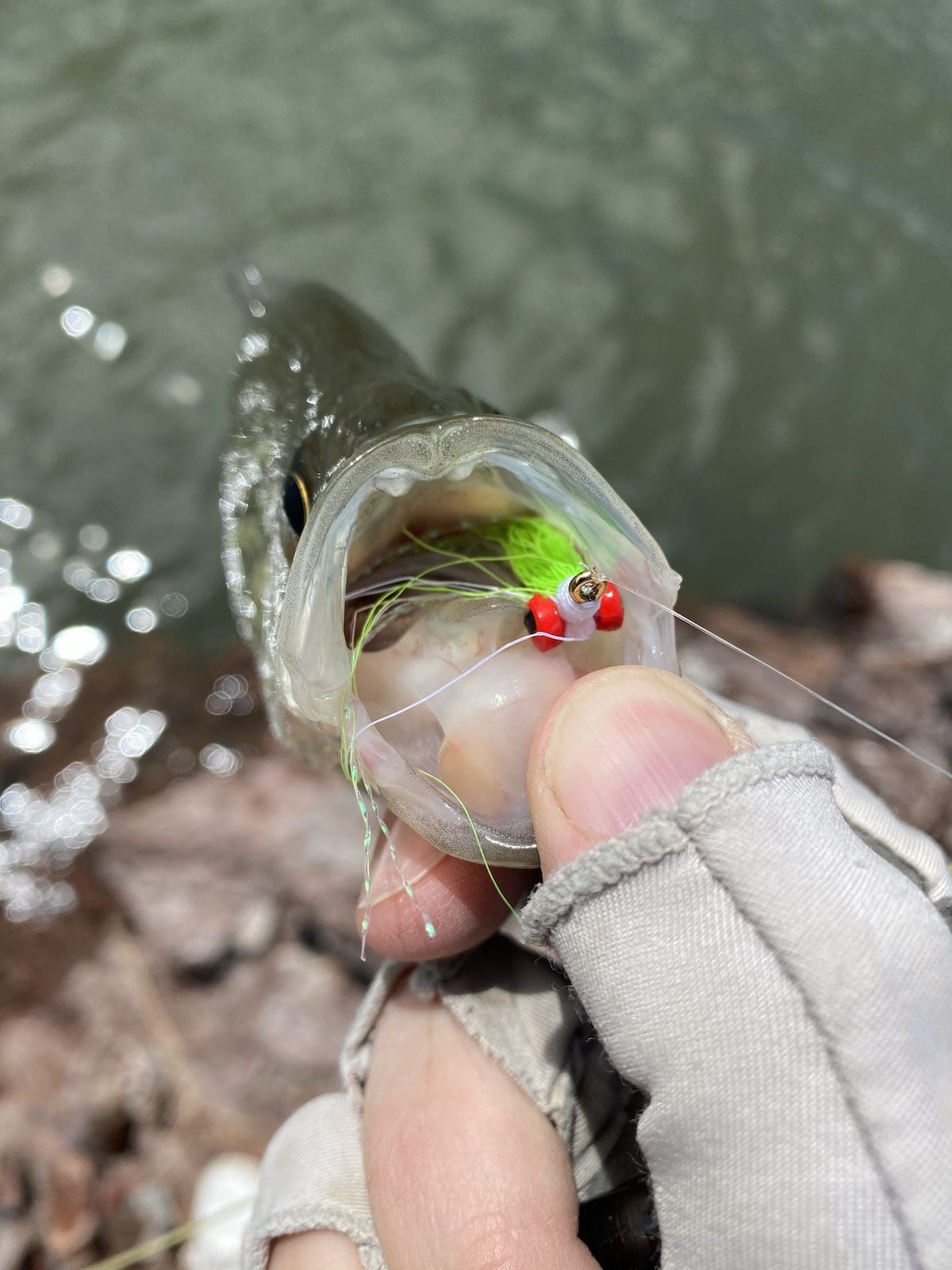
Here’s a voracious black crappie I caught on a chartreuse and white clouser minnow pattern.
When to Target Crappies
There’s only one time of year that makes sense for fly fishers to target crappies, and that’s during spring. Period.
Yes, you can catch crappies on a fly during the summer and fall, but it becomes much more challenging during these seasons because the crappies are holding in deep water. You’d need to dredge the bottom using full sinking line, likely from a boat or other watercraft. It’s just not as fun, and not nearly as productive.
Springtime is when crappies spawn, and this is the ideal time to catch them.
Depending on which state you fish in, spring can mean different things. You’ll want to target these fish in April and May in most areas. The ice should be off the water, and the shallows should be warmed by the sun. Crappies will show up in droves to spawn well before bluegills and largemouth bass are active.
The easiest way to be sure is to get yourself a water thermometer. Crappies migrate from the deep once water temperatures hit 45F-50F. Around 55F, they’ll start staking out spawning areas. Around 60F, the males will begin digging spawning beds. The entire preceding period is called the pre-spawn, and crappies begin feeding heavily during this time.
Once the water hits around 62F-65F, spawning will begin. During the spawn, crappies will continue hitting flies hard.
Remember, these are water temperatures, not air temperatures.
Sunny days, overcast days, and cloudy days can all be productive.
Once they finish spawning, which is usually late May or early June, they’ll head back to the depths.
Time of day
The best time of day to catch crappies is either early morning or late afternoon.
You can catch them at any time of day, but if I had to choose just one three or four hour period, it’d be late afternoon.
Earlier this spring, I stood on the shoreline of a local reservoir and caught 50+ crappies on various flies during a four hour window. I’m not going to lie, it actually got a little old. Fortunately, there were two smallmouth bass that snuck into the net to mix things up.
My point is, when it’s springtime and you locate a school of crappies, buckle up because it’s going to be a busy day. Their numbers can seem inexhaustable.
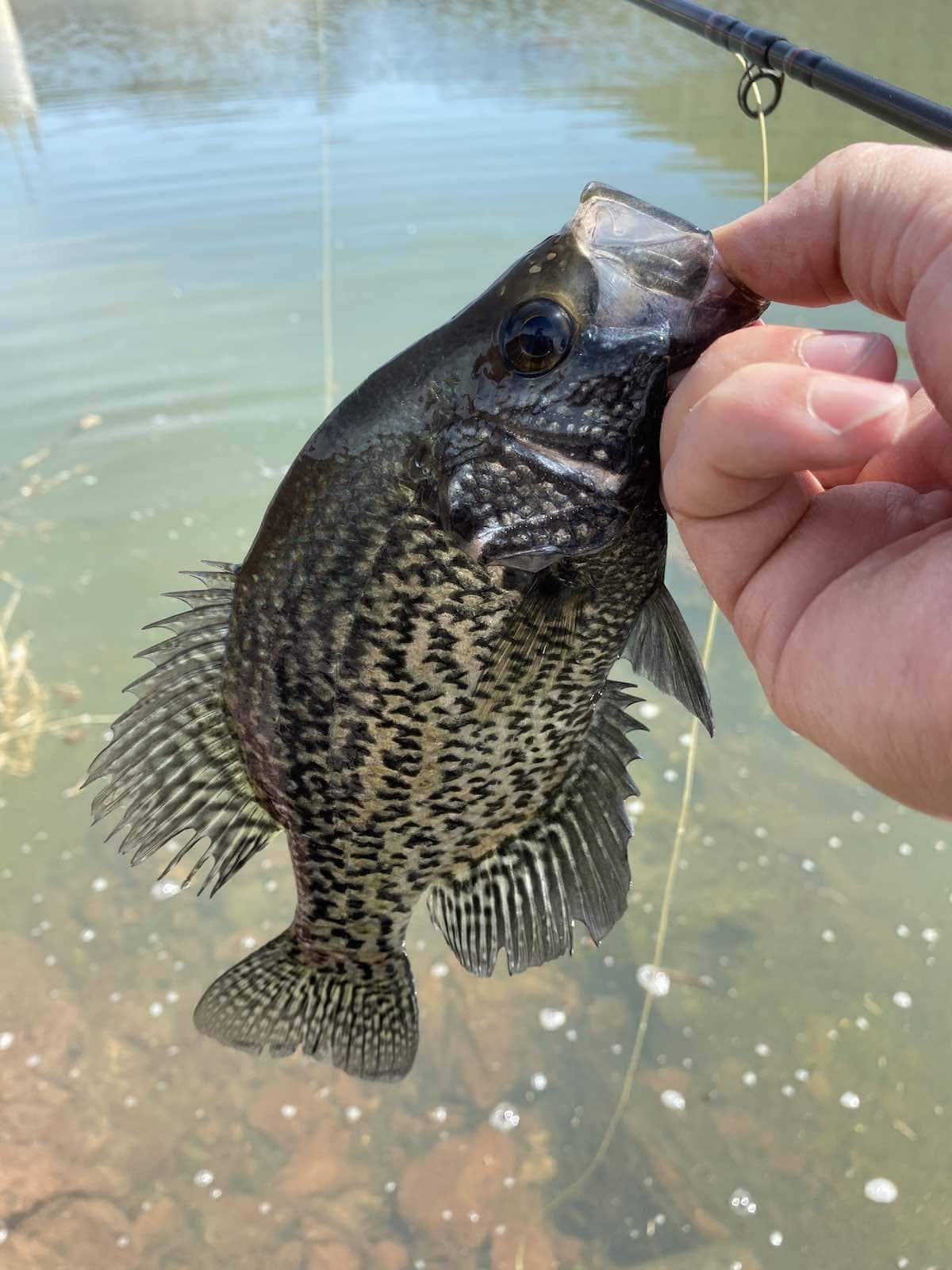
In the background of the above picture, you can see the water depth increase dramatically. The crappies were holding 5-15 feet below, along rocky walls.
Crappie Fly Fishing Tactics
When I was quite young, one set of my grandparents had a small home on a lake in the Midwest. It was a lake fed by a river, so it contained many species of fish including musky, northern pike, crappies, catfish, and sheepshead. We used to cut out the small stones inside the sheepshead skulls, which always had a “J” carved into them for whatever reason.
Anyhow, my grandma focused on crappies, and she and I would go out in her small outboard boat and troll for them with jigs. Once she found a school of crappies, we’d criss-cross the school repeatedly, catching more than enough for dinner. I despised eating fish, but I would grind through the meal somehow.
The reason I mention this story is because finding a school of crappies should be your first and only priority. You’ll almost never find rogue, individual crappies roaming around. They school-up, sometimes in huge numbers.
When you find a school, the action can be nonstop.
I mentioned earlier that you can find schools near drop-offs and structure. Often times, if you’re using polarized sunglasses, you’ll see a few crappies holding several feet down. You can be sure there are more nearby.
Stripping streamers
My favorite method, once I find a school, is to cast a weighted streamer and strip it back to me. Crappies aren’t picky eaters, and I focus on streamer sizes of 10-16, usually with a tungsten beadhead. Some beadheads are made of alloys that aren’t heavy and don’t sink well, but tungsten is heavy and will get your fly down.
Most of the time, I simply use weight-forward floating line, and about 6-8 feet of fluorocarbon leader, usually 5X. Fluorocarbon line is less visible, and stronger, than monofilament–and it sinks, unlike mono.
During the spring, the water is colder and fish aren’t moving quickly. So, don’t strip your streamer in too quickly. Keep things slower.
Crappies will often follow your streamer or fly for several feet, analyzing its locomotion, then take it in a blur in between strips. In other words, as the fly is dropping through the water. If you can see the crappie, you can set the hook accordingly.
But, if you can’t see the crappie, they can inhale then expel your fly without your even noticing. Similar to what smallmouth bass will do.
Being able to see crappies as they follow your streamer in is a blast. They’re good fighters too.
Stripping cadence
I’ve never found a stripping cadence that works best with crappies all the time. Some crappies like it a little faster, some like it moderate, and some will take it when your fly is barely moving. Always experiment.
As a starting point, try stripping 4-6 inches of line at a time, with a 1-2 second pause in-between strips. If this doesn’t work, do shorter strips until you hone in on the speed the fish want.
Catching crappies on the surface
Some people swear that poppers work well for crappies, but I’ve found this to be the exception rather than the rule.
You’re going to want to focus on subsurface patterns. It’s a rare spring day when crappies are eating off the surface.
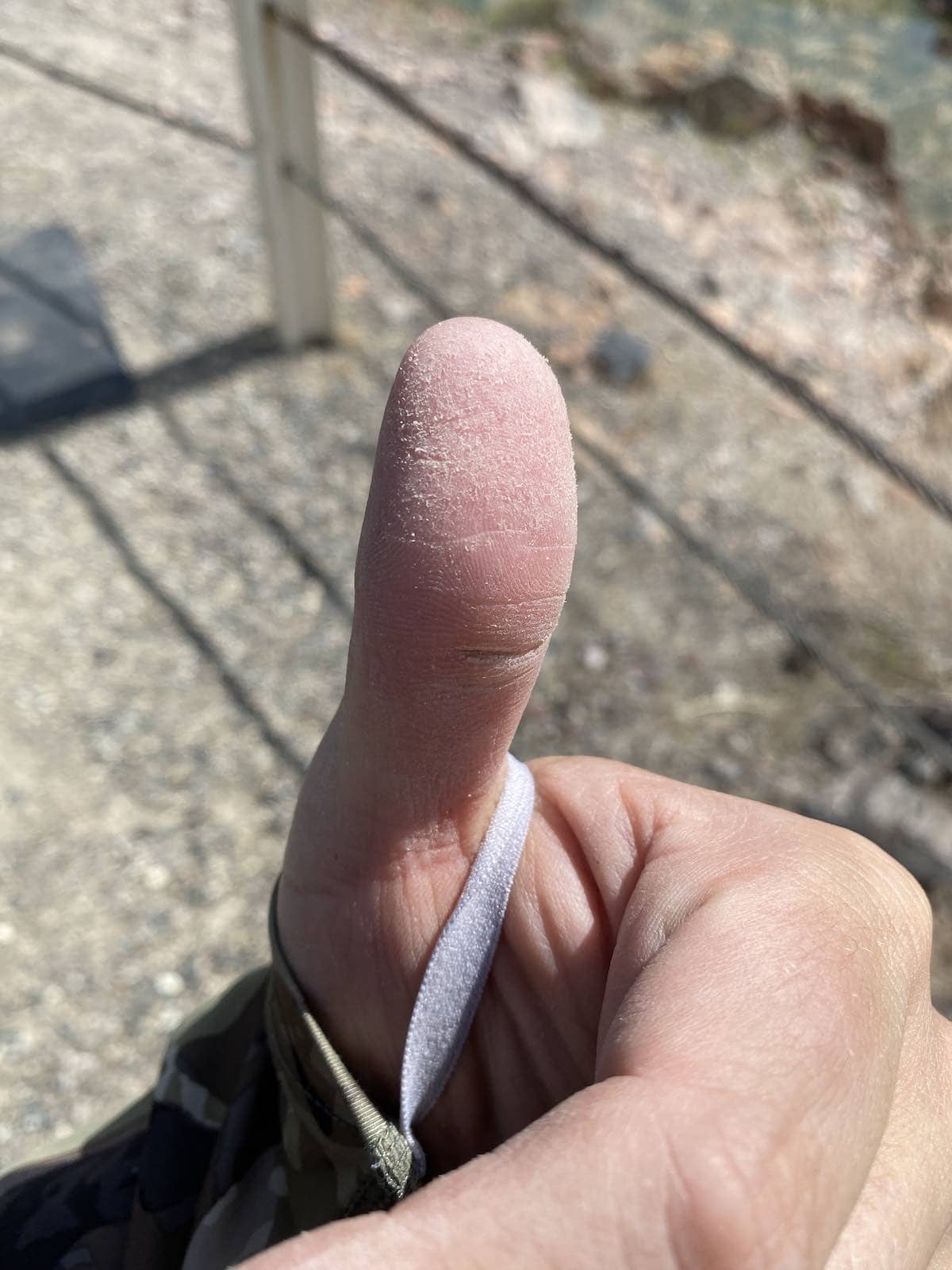
This is what your thumb’s going to look like after you catch 50+ crappies. Their small teeth are like rough sandpaper on your skin.
The Best Flies for Crappies
While it’s true that crappies aren’t discriminate eaters, some fly patterns have stood out above the rest over the years. It’s worth mentioning that certain flies work better on certain days, which is why I always say to experiment, because you don’t always know what insects are hatching underwater, or what minnows are in the area.
Even when you get into a school of crappies, they’ll eventually catch on and start avoiding your fly. So, when the bite inevitably slows, change flies, or try a new color.
Below I’ll detail the best crappie flies I’ve ever used.
Streamers for crappies
Aggravator
This isn’t a common fly, but it’s not uncommon.
The brass-colored beadhead gives it some weight and some flash, while the rubber legs give it some life, imitating everything from a minnow to a damselfly nymph.
I’ve caught many crappies on this pattern, it’s one of my go-to flies, and I usually get a smallmouth bass or two as a bonus.
Use this in sizes 10-14.
Leech patterns
Ah, leeches. They’re just so utterly effective, and not just for crappies.
I use a tungsten beadhead version, usually in sizes 8-12. You can use a bunny leech, jiggy leech, or just about any variant.
Earlier this year I had a gorgeous rainbow trout take my leech pattern while I was targeting crappies. You never know.
You can get a handful of effective leech patterns on this page at Amazon.
Clouser minnow
No streamer box could ever be considered complete without the addition of Clouser minnows. This is an iconic fly pattern, and I use them in sizes 8-14 for crappies. The picture near the top of this article shows a crappie I just caught, with a clouser in its throat. You can get the exact same pattern on this page at Amazon.
Usually I use a chartreuse and white color pattern, but crappies seem to really like red and white too, even though researchers have discovered that red is one of the least visible colors underwater. Tell that to the red-and-white Daredevle spoon, right?
Honorable mention: Woolly bugger
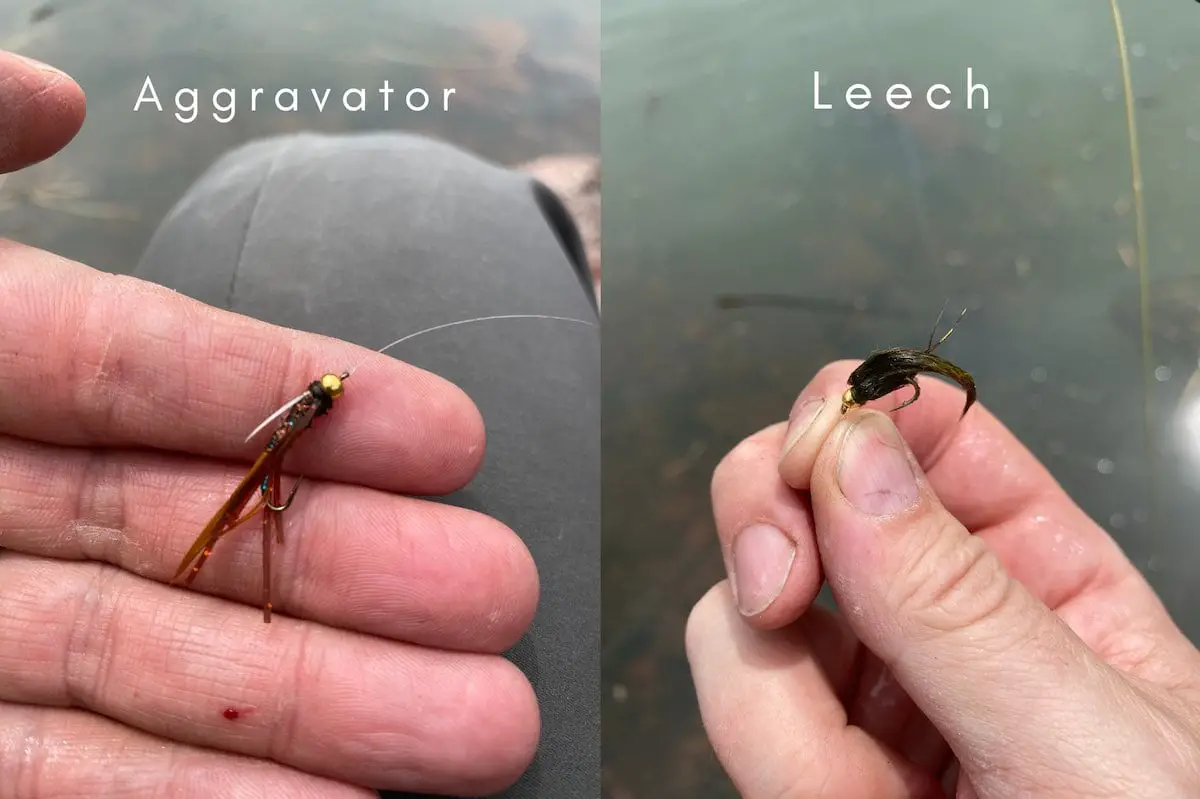
Nymphs and wet flies for crappies
Drifting a nymph under and indicator (bobber) isn’t my cup of tea, but to each his own. It’s a proven method for catching crappies, but usually only if there’s a mild current or wind, or if slowly retrieved. If the water is completely still, you won’t have as much success.
You can strip-in nymphs as well, treating them as small streamers. There are very few rules in fly fishing, so experiment and find out what’s working.
Prince nymph
I think the reason this fly works well is because it’s buggy. It looks like an offshoot of the aggravator pattern I mentioned earlier.
Use a weighted version of this fly in sizes 10-18. You can find this exact pattern on this page at Amazon.
Pheasant tail
This is probably the most ubiquitous nymph in the U.S., and for good reason. It’s super productive, and you should have them in your fly box regardless of whether you target crappies or not.
Use a weighted version of this fly in sizes 12-18. You can find this exact pattern on this page at Amazon.
Wet Flies
I don’t personally use wet flies very often when I’m chasing crappies. The main reason is that most of them are unweighted, and it’s challenging to get them deep. That is, unless you’re using full sinking line, or adding weight to your leader.
Adding weight to your leader isn’t ideal, because it creates a “hinge” in your setup and makes bite detection even tougher.
When I do use wet flies, my favorite pattern is a soft hackle beadhead version of the pheasant tail.
I recommend sizes 12-14.
Honorable mention: Copper john
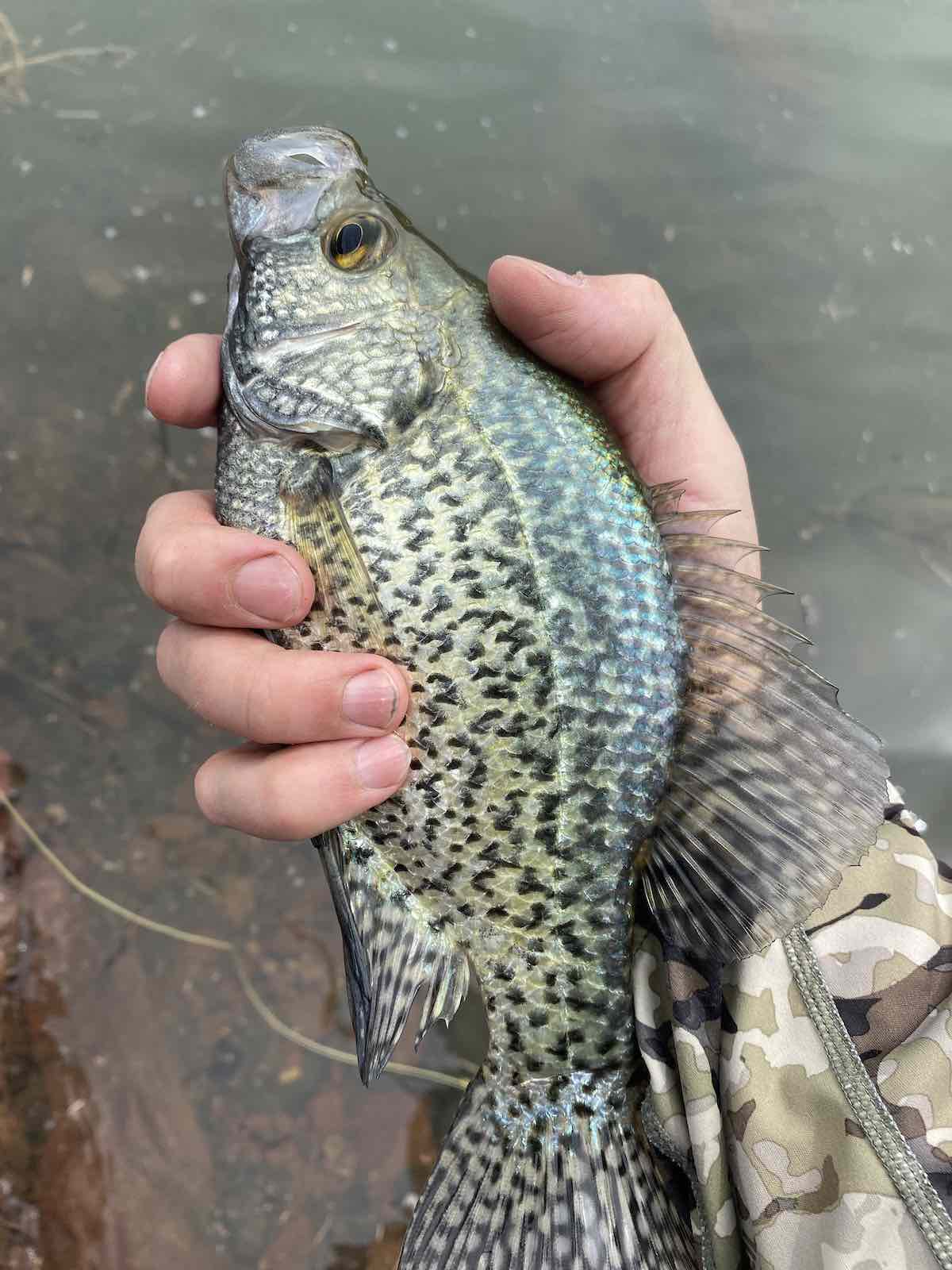
What do Crappies Eat?
Newly hatched crappie fry eat tiny foods like zooplankton until they’re large enough to consume larger prey items such as scuds, nymphs, chironomids (midges), and similarly sized animals.
Sub-adult and adult crappies will eat tadpoles, small crayfish, and dragonfly nymphs. But their favorite food is minnows and very young panfish and gamefish (think largemouth bass, bluegill, etc).
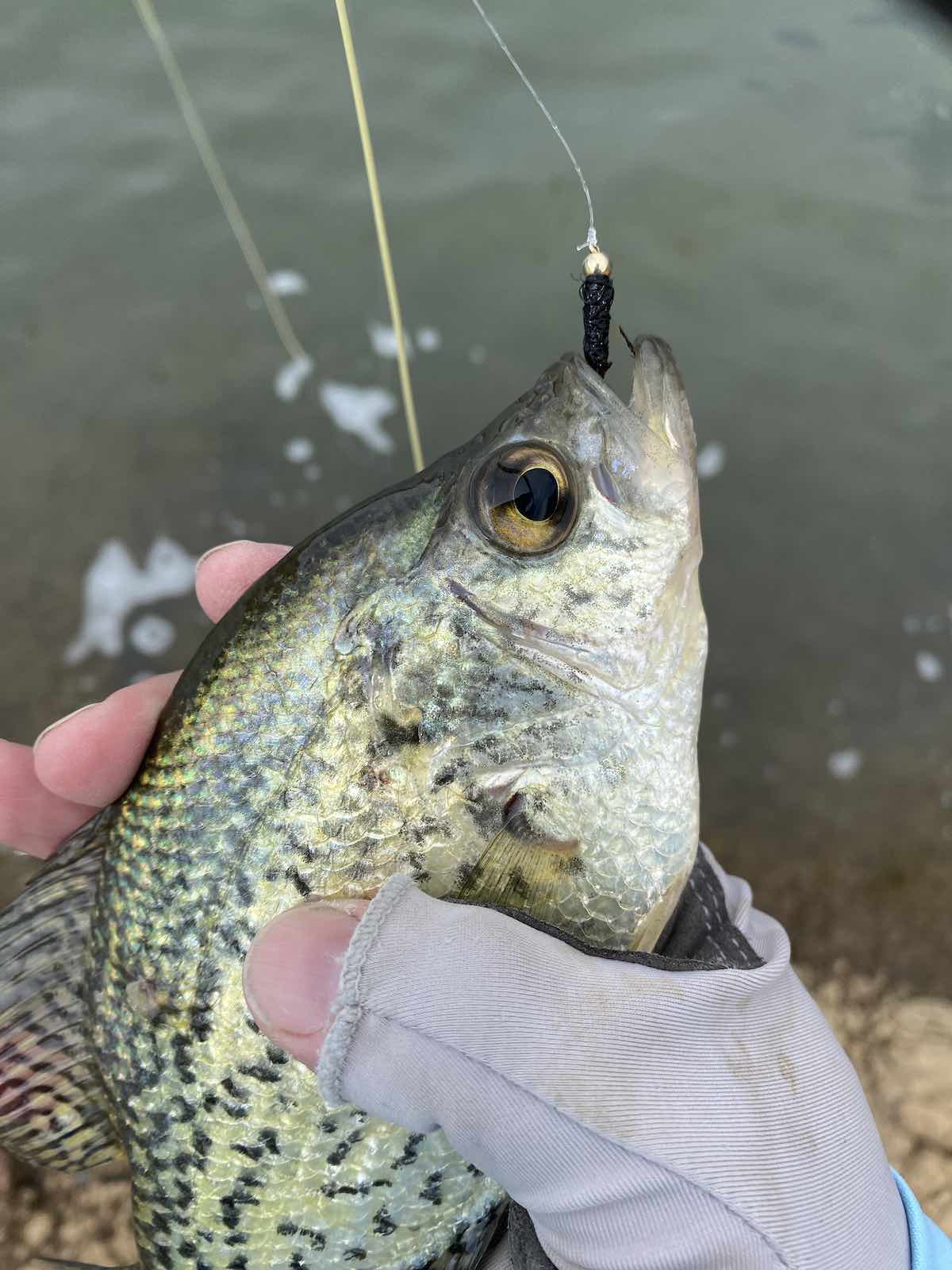
Recommended Fly Gear
Fly Rod
I recommend you use a 4-weight or 5-weight fly rod for crappies. Sure, you could use a 3-weight, but these fish aren’t caught in small streams and rivers tucked into forests. Crappies are generally caught on wide-open bodies of water that often have considerable wind.
Wind matters.
When it’s windy, casting will be much easier with a 5-weight when compared to a 3-weight.
Also, a stronger rod will have an easier time tossing weighted streamers.
Fly Reel
Almost every crappie you’ll ever catch can simply be stripped-in manually, meaning you don’t use your reel at all.
Regardless, you’ll want to get a quality reel since other species you chase may require something sturdy. Sage, Bauer, Orvis, Abel, Hardy, and several others are all reliable reel companies.
Most fly reels can be adjusted easily for left or right-handed retrieval.
Fly Line
Since you’ll likely focus on crappies during springtime when they’re in the shallows, I’d recommend you use a simple weight forward floating line.
If you’re going to chase crappies during summer and fall when they’re in deep water, you’ll want a full sinking line. Full sinking line starts sinking the moment it hits the water, and they’re rated by IPS (Inches Per Second) sink rates. I’d recommend something in the 5-7 IPS range.
A sink tip line is another option, sort of a hybrid between floating line and sinking line. Most of the fly line is floating line, but the last 10-20 feet of line will sink. So, the tip of the line sinks, thus the nomenclature.
If you’re drifting nymphs, or using hoppers, stick with floating line.
Leader & Tippet
There’s no need to overthink your leader here. I’d recommend using a simple 7 to 9 foot knotless tapered fluorocarbon leader in the 5X range. That’s it. Super simple.
The same applies whether you’re casting streamers or drifting nymphs. If you’re casting hoppers or anything on the surface, you can use regular monofilament line instead, since it won’t sink.
General Gear
If you’re curious, don’t miss reading about my favorite fly fishing slingpack of all time. It’s an invaluable piece of equipment.
A reliable pair of forceps or hemostats is mandatory. If you don’t already have this vital tool, I published an article detailing the best fly fishing forceps and how to use them.
Crappies often times inhale your fly, and you’ll regularly need the precision that forceps provide when you’re removing deep hooks.
This’ll help with getting the fish back into the water as soon as possible. Don’t fish without forceps.
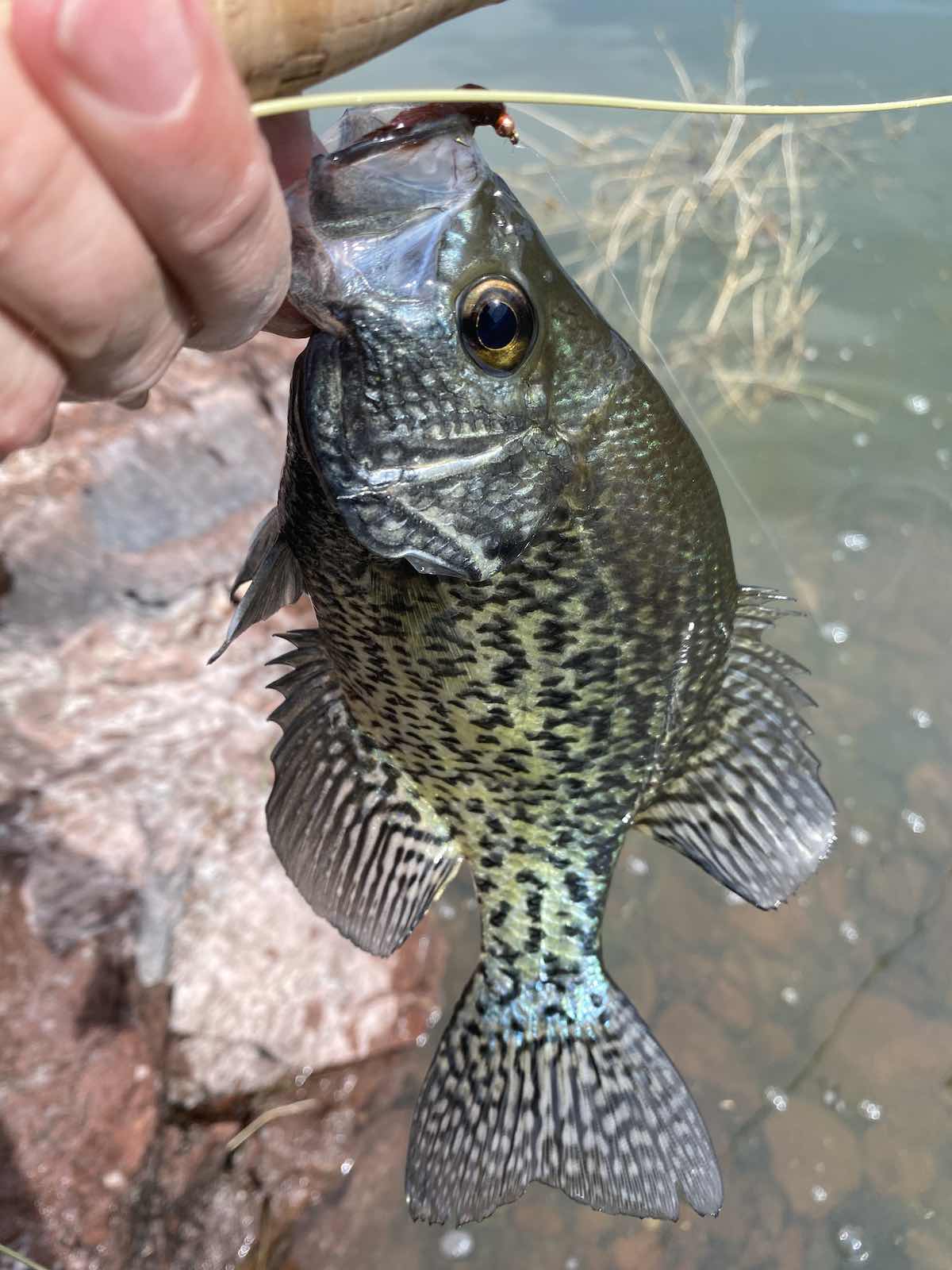
There’s something really satisfying about an afternoon catching crappies. They’re in the shallows during a small window in spring, and well worth your time. Fly fishing for crappies is fast paced!
Summary
The crappie fly fishing season is abbreviated, but it’s a fast-paced period of time when you can literally catch hundreds of fish in a single day. I’m not necessarily saying you should, but it’s possible when you key-in on the right areas with the right flies.
Crappies are usually about twice the size of your average bluegill, they fight harder, and they love chasing streamers. If you’ve got a standard 9-foot 5-weight fly rod with floating line, you’re all set.
Do some online research with your state’s Fish and Wildlife department (or DNR) and figure out which lakes and reservoirs near you hold crappies. In April, start scouting and get ready for some fun!
Don’t miss my related articles on fly fishing for rainbow trout, fly fishing for brown trout, and fly fishing in ponds.
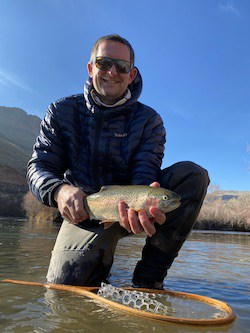
About the Author
My name's Sam and I'm a fly fishing enthusiast just like you. I get out onto the water 80+ times each year, whether it's blazing hot or snow is falling. I enjoy chasing everything from brown trout to snook, and exploring new waters is something I savor. My goal is to discover something new each time I hit the water. Along those lines, I record everything I learn in my fly fishing journal so I can share it with you.
Follow me on Instagram , YouTube, and Facebook to see pictures and videos of my catches and other fishing adventures!
